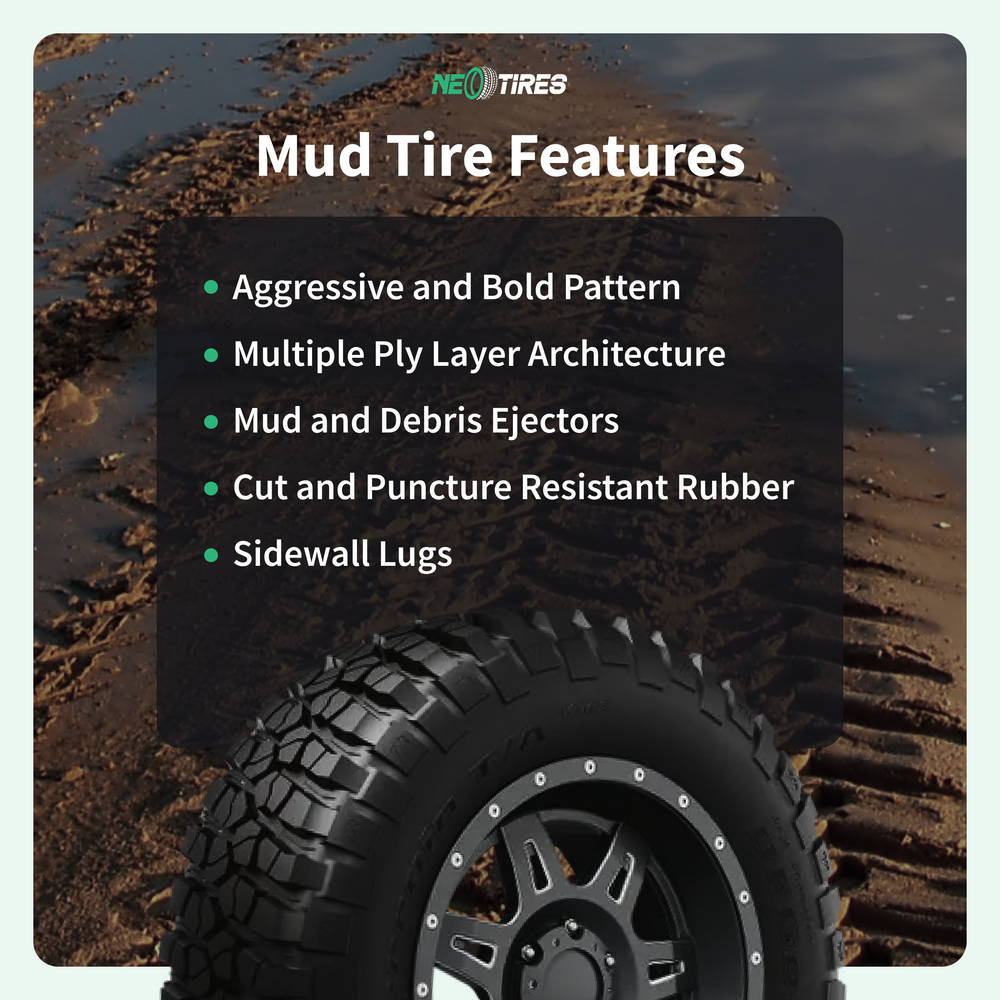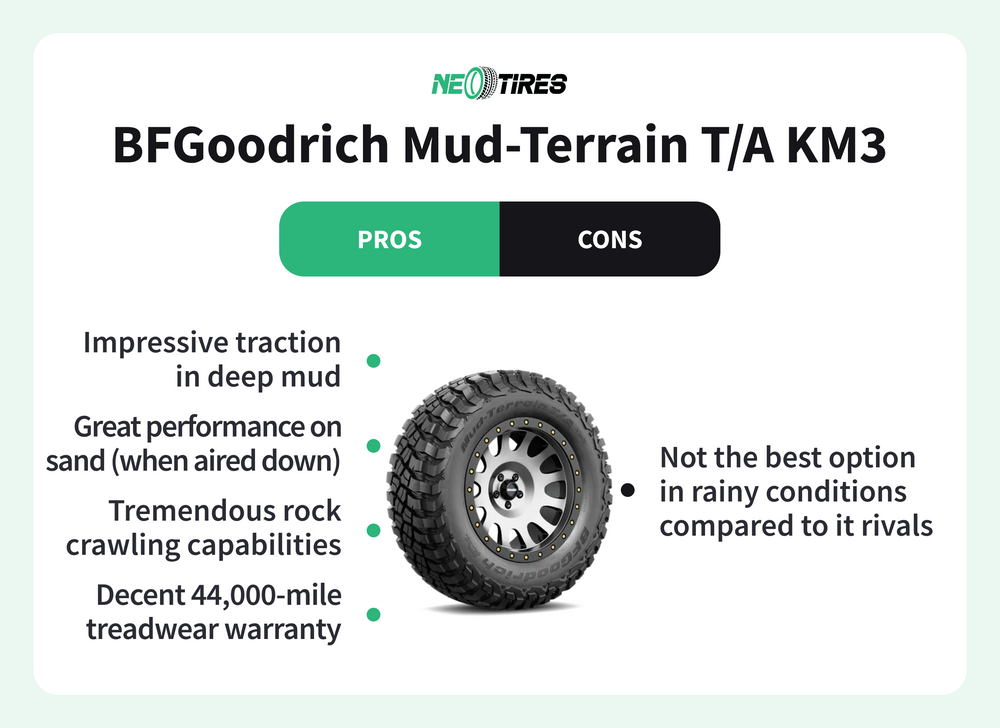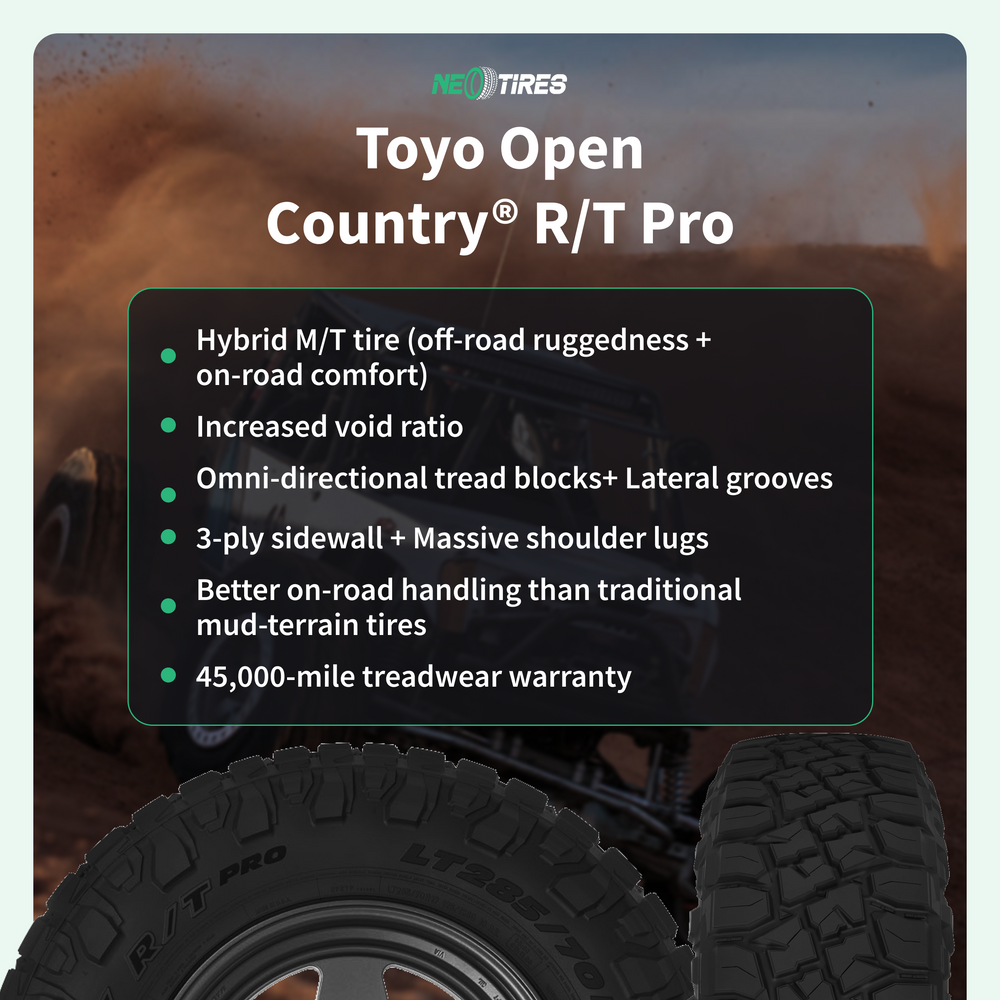Mud-terrain tires are the best bet for adventurers who embrace wild trails, rocky backroads, and slippery forest paths. Every bit of mud tire DNA is designed for serious traction and durability, so nothing gets in the way of exploring rough terrain.
Today, we will unlock everything you need to know about MT tires, from their key features to comparing different models. This section will help you find your ideal mud ally for your next wilderness adventure, whether in nature, on mountains, or rocky paths.
What Are Mud Tires For?
The primary purpose of mud tires is to handle serious off-road driving conditions where other tires can't handle. More specifically, MT tires are perfect for sand, mud, loose terrain, slush, and uneven rocky terrains all in one. What sets them apart from other tire types is their rugged construction, superior traction, and self-cleaning capabilities, which provide consistent power and grip.
Mud Tires are an optimal solution if:
- You own a 4x4, Jeep (or any other vehicle designed for outdoor tasks), or a lifted truck
- You frequently or occasionally explore off-road terrain
- Tackle muddy trails and uneven surfaces more than highways
Mud Tires Key Features
The unique features of MT tires include their aggressive tread design, which promotes grip in mud and loose terrain; sidewall lugs that reduce the risk of punctures; self-cleaning channels that evacuate debris (mud, rocks, slush) and ensure consistent traction; and reinforced construction that provides tolerance against trail hazards.
| Feature | Description |
| Aggressive Tread Pattern | Large tread blocks and deep voids help grip muddy and loose surfaces |
| Sidewall Lugs | Thick, rugged sidewalls with protruding lugs improve grip and reduce puncture risk |
| Self-Cleaning Channels | Expel mud, rocks, and debris to maintain consistent traction. |
| Reinforced Construction | Built with 3-ply sidewalls or stronger for durability against sharp rocks and terrain hazards |
Mud-Terrain VS All-Terrain Tires
All-terrain (AT) tires are a more versatile version of mud-terrain (MT) tires, both of which are part of the off-road tire class. While both are reliable options for navigating rough terrain, they differ primarily in the traction they provide on aggressive surfaces and the level of comfort they offer on the highway.
In short, a mud tire is much more capable in aggressive off-roading conditions, but becomes noisy on smooth roads. All-terrain (AT) tires, in contrast, deliver acceptable off-road performance but are not as competent as their mud-terrain (MT) counterparts.
However, all-terrain models offer decent comfort and quietness on the road, making them an optimal choice for mixed driving conditions. Tire Rack and Off-Road.com recommend mud tires for serious off-road adventures, while all-terrain (AT) alternatives are best suited for daily driving with occasional dirt roads.
| Feature | Mud Terrain Tires | All-Terrain Tires |
| Off-Road Performance | Superior grip in mud, rocks, sand | Moderate off-road performance |
| On-Road Comfort | Noisier and stiffer | Smoother and quieter ride |
| Durability | Built for rugged terrain | Versatile but less tough |
| Tread Life | Typically shorter | Longer treadwear warranty |
| Best For | Frequent off-roading | Mixed driving, light trails |
Difference between AT tires and MT tires
Can You Use Mud Tires in the Snow?
Mud tires perform decently in snowy conditions due to their aggressive tread pattern, which bites through snow to enhance traction. However, their design and rubber formula are not optimized explicitly for winter (unless it's a rarely met 3PMSF model).
A winter-specific tire stays soft in extreme temperatures. Its siping ensures traction and grip in snow. Mud tires lack siping features, which limits their use against severe winter conditions. All-terrain tires (with a 3PMSF symbol) or winter-specific tires are a more reliable choice for harsh snow conditions.
3 Mud Tires To Consider
The variety of mud tire options is endless, making the choice a tough one. Here are three standout models that rank high in terms of serious performance in off-road conditions and deliver everything a genuine MT tire can deliver: BFGoodrich Mud-Terrain T/A KM3, Cooper Discoverer STT Pro, and Toyo Open Country R/T Pro.
BFGoodrich Mud-Terrain T/A KM3
The BFG T/A KM3 is a standout option for all-around off-road performance. The product delivers superior performance on rocky and slippery surfaces thanks to its advanced Krawl-TEK compound. The CoreGard Max Technology and thick sidewall lugs ensure high resistance to punctures and various off-road hazards—additionally, the tire self-cleans quickly, allowing for consistent traction and superior grip on any challenging terrain.
Cooper Discoverer STT Pro
The Discoverer STT Pro is an all-terrain product that meets all the criteria of a genuine MT tire. Cooper describes it as "the most advanced, extreme, and capable off-road tire to date" in its portfolio, and real-world driver ratings confirm it.
The Discoverer STT Pro tire features Armor-Tek3 construction, ensuring sidewall strength in extreme conditions. The product also contains a high concentration of silica, which makes it wet-weather grippy. The vehicle passes through deep mud and rocky terrain with ease, thanks to the tire's alternating shoulder lugs, which promote superior and stable traction.
Toyo Open Country R/T Pro
The new Open Country R/T Pro is a rugged-terrain product that performs superbly in severe mud conditions. This tire is ideal for drivers covering rough and mixed surfaces, as it blends both serious off-road performance and on-road manners.
Its bold and aggressive pattern with deep voids efficiently ejects mud, slush, and off-road debris, while the reinforced 3-ply sidewalls promise superior puncture resistance. The Open Country R/T Pro is extremely capable on rough terrain while remaining comfortable on the road, making it a perfect alternative for drivers who frequently switch between road and trail.
Mud Tires: FAQs
How Long Do Mud Tires Last?
MT tires serve between 20,000 and 40,000 miles, on average. Their longevity depends on the abuse they are exposed to in off-road conditions. Generally, the purpose of mud-terrain tires is to deliver superlative performance in serious off-roading, durability against damage, and traction rather than longevity.
Are Mud Tires Optimal For Daily Driving?
Mud tires are not optimal for daily driving on smooth and asphalt surfaces. Using mud tires on pavement leads to rapid wear, inefficient fuel consumption, and high road noise, as their primary purpose is to tackle a serious off-road environment. Consider all-terrain tires for hybrid driving conditions or touring tires for daily commuting instead.
Why Do Mud Tires Wear Faster?
The faster wear in mud tires results from the rubber softness, which is necessary to ensure off-road grip and superior traction. The purpose of mud tires is to provide extra traction on muddy and rough surfaces, which comes at the price of reduced tread life, rather than extending their lifespan on smooth roads.
Need Advice On Your Next Set Of Mud Tires?
Choosing tires can be challenging, as drivers must carefully consider their terrain, driving habits, and vehicle's needs and specifications. The NeoTires team is ready to guide you through the selection process to find the ideal set that meets your needs. Contact us for personalized assistance or browse our catalog to compare prices, features, and the best deals. Drive safe and choose your tires wisely!









